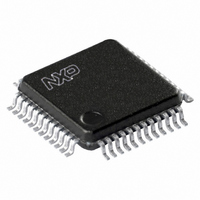PCA9626B,118 NXP Semiconductors, PCA9626B,118 Datasheet - Page 9

PCA9626B,118
Manufacturer Part Number
PCA9626B,118
Description
IC LED DRIVER RGBA 48-LQFP
Manufacturer
NXP Semiconductors
Type
RGBA LED Driverr
Specifications of PCA9626B,118
Package / Case
48-LQFP
Topology
Open Drain, PWM
Number Of Outputs
24
Internal Driver
Yes
Type - Primary
Backlight, LED Blinker
Type - Secondary
RGBA
Frequency
1MHz
Voltage - Supply
2.3 V ~ 5.5 V
Voltage - Output
40V
Mounting Type
Surface Mount
Operating Temperature
-40°C ~ 85°C
Current - Output / Channel
100mA
Internal Switch(s)
Yes
Number Of Segments
24
Low Level Output Current
100000 uA (Min)
Operating Supply Voltage
2.3 V to 5.5 V
Maximum Supply Current
18000 uA
Maximum Power Dissipation
1800 mW
Maximum Operating Temperature
+ 85 C
Mounting Style
SMD/SMT
Minimum Operating Temperature
- 40 C
Lead Free Status / RoHS Status
Lead free / RoHS Compliant
Efficiency
-
Lead Free Status / Rohs Status
Lead free / RoHS Compliant
Other names
568-4774-2
Available stocks
Company
Part Number
Manufacturer
Quantity
Price
Company:
Part Number:
PCA9626B,118
Manufacturer:
NXP Semiconductors
Quantity:
10 000
Part Number:
PCA9626B,118
Manufacturer:
NXP/恩智浦
Quantity:
20 000
NXP Semiconductors
PCA9626_2
Product data sheet
7.2 Control register
Following the successful acknowledgement of the slave address, LED All Call address or
LED Sub Call address, the bus master will send a byte to the PCA9626, which will be
stored in the Control register.
The lowest 6 bits are used as a pointer to determine which register will be accessed
(D[5:0]). The highest bit is used as Auto-Increment Flag (AIF).
This bit along with the MODE1 register bit 5 and bit 6 provide the Auto-Increment feature.
Bit 6 of the Control register is not used.
When the Auto-Increment Flag is set (AIF = logic 1), the six low order bits of the Control
register are automatically incremented after a read or write. This allows the user to
program the registers sequentially. Four different types of Auto-Increment are possible,
depending on AI1 and AI0 values of MODE1 register.
Table 3.
[1]
Remark: Other combinations not shown in
111b) are reserved and must not be used for proper device operation.
AIF + AI[1:0] = 000b is used when the same register must be accessed several times
during a single I
LED. Data is overwritten each time the register is accessed during a write operation.
AIF + AI[1:0] = 100b is used when all the registers must be sequentially accessed, for
example, power-up programming.
AIF
0
1
1
1
1
Fig 6.
AI1 and AI0 come from MODE1 register.
AI1
0
0
0
1
1
reset state = 80h
Remark: The Control register does not apply to the Software Reset I
Control register
Auto-Increment options
[1]
AI0
0
0
1
0
1
2
C-bus communication, for example, changes the brightness of a single
[1]
Function
no Auto-Increment
Auto-Increment for all registers. D[5:0] roll over to 0h after the last register
26h is accessed.
Auto-Increment for individual brightness registers only. D[5:0] roll over to
2h after the last register (19h) is accessed.
Auto-Increment for global control registers and CHASE register. D[5:0] roll
over to 1Ah after the last register (1Ch) is accessed.
Auto-Increment for individual brightness registers; global control registers
and CHASE register. D[5:0] roll over to 2h after the last register (1Ch) is
accessed.
Rev. 02 — 31 August 2009
AIF
Auto-Increment Flag
Don't care
X
D5
D4
register address
Table 3
24-bit Fm+ I
D3
D2
(AIF + AI[1:0] = 001b, 010b, 011b and
D1
002aad610
2
C-bus 100 mA 40 V LED driver
D0
2
C-bus address.
PCA9626
© NXP B.V. 2009. All rights reserved.
9 of 47
















